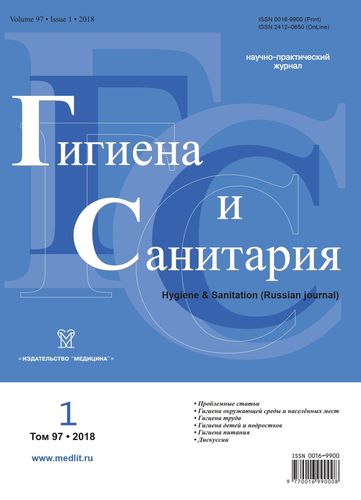The impact The impact of local zones of the waste storage on yeast communities in urban soils
- Autores: Tepeeva A.N.1, Glushakova A.M.1, Kachalkin A.V.1
-
Afiliações:
- Lomonosov Moscow State University
- Edição: Volume 97, Nº 1 (2018)
- Páginas: 50-53
- Seção: ENVIRONMENTAL HYGIENE
- ##submission.datePublished##: 14.10.2020
- URL: https://bulletin.ssaa.ru/0016-9900/article/view/640333
- DOI: https://doi.org/10.47470/0016-9900-2018-97-1-50-53
- ID: 640333
Citar
Texto integral
Resumo
The analysis of the number and species structure of yeast communities of urban soils near the sites of the household waste storage in the city of Moscow was executed using a standard method for sowing glucose-peptone-yeast medium. In all studied soils there were found yeast fungi whose abundance exceeds the indices for undisturbed soils. The identification of the collection of isolated strains based on the analysis of the nucleotide sequence of the D1/D2 domains of the large subunit of rDNA showed in urban soils the presence of 33 yeast fungi, a significant proportion which are species — Candida parapsilosis, C. tropicalis, Diutina catenulata, clinically important for the health of people. An analysis of the taxonomic structure of urban soils also showed marked changes in yeast groups compared to undisturbed soils: a lower proportion of basidiomycetes and a lack of typical pedobionts of the genus Solicoccozyma. The data obtained in the course of the conducted research testify to the advisability of observing the existing standards for storing household waste and the need for additional measures to reduce the risks associated with the presence of clinically important yeast species in similar zones within the city.
Palavras-chave
Sobre autores
Aleksandra Tepeeva
Lomonosov Moscow State University
Autor responsável pela correspondência
Email: sasha211092@inbox.ru
Post-graduate student of the Department of Soil Biology, Faculty of Soil Science, M.V. Lomonosov Moscow State University, Moscow, 119991, Russian Federation.
e-mail: sasha211092@inbox.ru
RússiaA. Glushakova
Lomonosov Moscow State University
Email: noemail@neicon.ru
Rússia
A. Kachalkin
Lomonosov Moscow State University
Email: noemail@neicon.ru
Rússia
Bibliografia
- Chernov I.Yu. Yeasts in Nature [Drozhzhi v prirode]. Moscow: KMK; 2013. (in Russian)
- Marfenina O.E. Anthropogenic Ecology of Soil Fungi [Antropogennaya ekologiya pochvennykh gribov]. Moscow: Meditsina dlya vsekh; 2005. (in Russian)
- Marfenina O.E., Kul’ko A.B., Ivanova A.E., Sogonov M.V. The microfungal communities in the urban outdoor environment. Mikologiya i fitopatologiya. 2002; 36(4): 22-32. (in Russian)
- Glushakova A.M., Kachalkin A.V. Endophytic yeasts in Malus domestica and Pyrus communis fruits under anthropogenic impact. Mikrobiologiya. 2017; 86(1): 114-22. (in Russian)
- Glushakova A.M., Kachalkin A.V., Tiunov A.V., Chernov I.Yu. Distribution of yeast complexes in the profiles of different soil types. Pochvovedenie. 2017; (7): 830-6. (in Russian)
- Dorko E., Kmetová M., Pilipcinec E., Bracoková I., Dorko F., Danko J., et al. Rare non-albicans Candida species detected in different clinical diagnoses. Folia Microbiologica (Praha). 2000; 45(4): 364-8.
- Guinea J. Global trends in the distribution of Candida species causing candidemia. Clin. Microbiol. Infect. 2014; 20(Suppl. 6): 5-10.
- Glushakova A.M., Kachalkin A.V., Zheltikova T.M., Chernov I.Yu. Yeasts associated with wind-pollinated plants - leading pollen allergens in Central Russia. Mikrobiologiya. 2015. 84(5): 612-5. (in Russian)
- Chernov I.Yu., Glushakova A.M., Kachalkin A.V. Annotated list of yeasts from Moscow region. Mikologiya i fitopatologiya. 2013; 47(2): 103-15. (in Russian)
- Yi L., Chai A., Denning D., Warn P. Candida tropicalis in human disease. Crit. Rev. Microbiol. 2010; 36(4): 282-98.
- Kothavade R.J., Kura M.M., Valand A.G., Panthaki M.H. Candida tropicalis: its prevalence, pathogenicity and increasing resistance to fluconazole. J. Med. Microbiol. 2010; 59(Pt. 8): 873-80.
- Mishra N.N., Prasad T., Sharma N., Payasi A., Prasad R., Gupta D.K., et al. Pathogenicity and drug resistance in Candida albicans and other yeast species: a review. Acta Microbiol. Immunol. Hung. 2007; 54(3): 201-35.
- Jabra-Rizk M.A. Fungal infections and drug resistance. Emerg. Med. Crit. Care. 2006; (7): 1-7.
- Roostita R., Fleet G H. The occurrence and growth of yeasts in Camembert and blue-veined cheeses. Int. J. Food Microbiol. 1996; 28(3): 393-404.
- Roostita R., Fleet G.H. Growth of yeasts in milk and associated changes to milk composition. Int. J. Food Microbiol. 1996; 31(1-3): 205-19.
- Radosavljevic M., Koenig H., Letscher-Bru V., Waller J., Maloisel F., Lioure B., et al. Candida catenulata Fungemia in a Cancer Patient. J. Clin. Microbiol. 1999; 37(2): 475-7.
- Santin R., Mattei A.S., Waller S.B., Madrid I.M., Cleff M.B., Xavier M.O., et al. Clinical and mycological analysis of dog’s oral cavity. Braz. J. Microbiol. 2013; 44(1): 139-43.
- Hagler A.N. Yeasts as indicators of environmental quality. In: Rosa C.A., Peter G., eds. Biodiversity and Ecophysiology of Yeasts. Germany: Springer-Verlag Berlin Heidelberg; 2006: 515-32.
- Wójcik A., Kurnatowski P., Błaszkowska J. Potentially pathogenic yeasts from soil of children’s recreational areas in the city of Łódz (Poland). Int. J. Occup. Med. Environ. Health. 2013; 26(3): 477-87.
Arquivos suplementares








